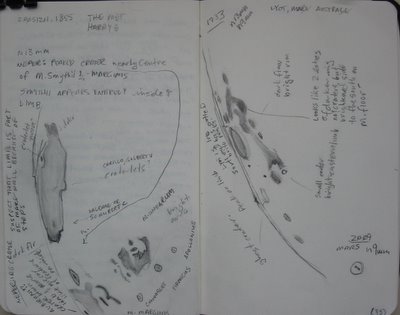20051211 - Gallivanting along the Libration Zone
Session Name: 20051211.1855
Last night I focused on Moon's eastern libration zone. Clouds would blanket the sky but after I got some time in observing. I spent a considerable amount of time with Mare Marginis, Mare Smythii, and Mare Australe. I did look at Mare Humboldtianum, really to see how its location near the limb changed, watching it climb back to the farside.
I didn't venture far from home. I set up the homemade 6" F/6 reflector, known as Harry just across the street from my front door. There is a small courtyard there from where I could follow Moon before it is obstructed by my building to manhattan-south. Pages from my notebook appear below. (Note Mars in the lower left corner.)

I don't recall seeing as much detail of these features as I may have in the past. I attribute it to sketching where one pays a considerable amount of attention to detail - at least I try :^D Even the weather played a part, where the night before I had the 10" out up at TotL but felt this evening's session provided better seeing. The detail around Mare Australe was incredible, and unfortunately my sketching skills do not impart the fantastic detail and changing shades of the lunar surface. The serpentine-like crawl of the mare in front of (interior to) the large crater Lyot reminds me of the same undulating flow of Mare Frigoris. Like a personal asterism, Mare Frigoris' shape is felt all about the lunar disk in other features. A similar twisting shape is a feature just interior to Mare Marginis; Mare Anguis writhes east northeast of Mare Crisium.
In Mare Smythii, I could see two areas where craters were apparent. One to the north was fairly sizable, such that easy to pick up, and it was situated just beyond the darkening tip of the mare. The other was more central to the mare and could have been more than one craterlet. Like all features along the limb, its easy to imagine that these are round shapes, but when sketching long thin ellipses and polygons are more the case. When regarding the shapes and composing where they lie with relation to other features, the curvature of the lunar surface is really emphasized in the seeing. It was difficult to say whether the mare was entirely inside the limb. I noticed a peak and some "un-smoothness" along the limb and wondered if that was part of the mare's far eastern rim. Most of the time I felt the whole mare was on the lunar disk, albeit severely foreshortened. Finally, Mare Smythii contrasts significantly from maria Marginis & Australe in that it at least appears to be a large foreshortened round formation. The other two maria are splattered patches of dark colored floor, sometimes discontiguous or of animated shapes.
At first glance, Mare Marginis appears as a partial gingerbread man figure. Large crater Neper with two peaks, cheating to the south, sits between Smythii and Marginis. My notes state that it is nearly central but the sketch shows much closer to Marginis. I could check the atlas but hopefully tonight will be clear to validate it. On the northern end of mare between it and the limb, either a mare-floor feature or a crater was observed just interior to the limb.
----- ------- ------
One can see how libration is favoring Mare Australe by visiting Vern's Blog. He has imaged three days of Moon: 12/07/2005, 12/08/2005, 12/11/2005. I downloaded the images and sequenced the 3 images. One can see how Mare Australe increasingly rolls on to the lunar disk. Conversely, one can see up along the northern limb, Mare Humboldtianum roll off the disk towards the farside. Changes with maria Marginis and Smythii are not as apparent.
In a comment to a previous post, Ben pointed out the animated gif on wikipedia.org that shows libration.
I showed a few people Mars and observed for short period. The best magnification was 100x, 180x was pushing it. In addition to a few of the passersby, I could see a dark mare feature running slightly vertical across the disk in the field of view. Nothing more than that, other than it is growing smaller by the day.
----- ------- ------
The following are my current lunar reference materials.
*Software*
Virtual Moon Atlas by Christian Legrand and Patrick Chevalley.
*Atlases*
Photographic Atlas of the Moon by S.M. Chong, Albert Lim, P.S. Ang
Exploring the Moon Through Binoculars by Ernest H. Cherrington, Jr.
Atlas of the Moon by Antonin Rukl
<< Home